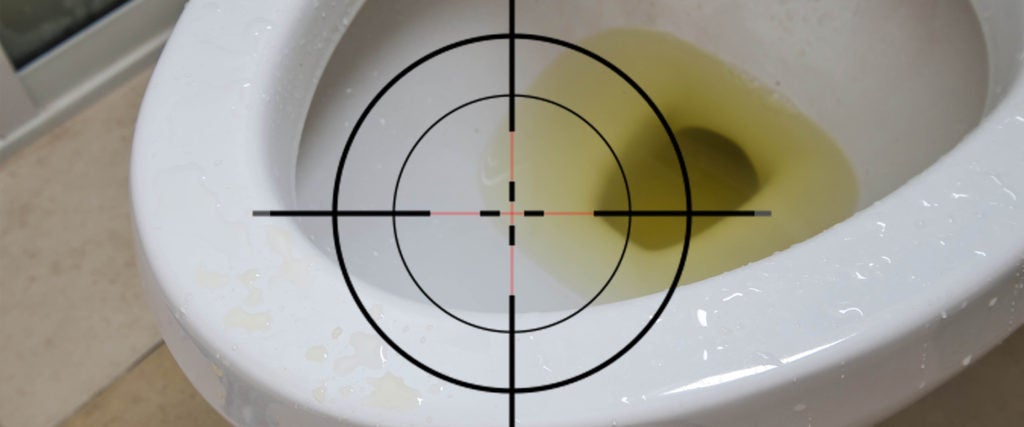I’ll be honest, despite having done it maybe a million times, I’m not super-great at peeing. Don’t get me wrong, as the only brother to four older sisters, I’ve been cleaning up whatever splatter remains on the toilet afterward for as long as I can remember. But for some reason, I’ve also never wondered whether a change in my pee-havior (sorry) would result in nary a splash at all.
In order to figure this out without pissing all over my bathroom, I reached out to nuclear physicist Sam Novario, who helped guide me through the stream of complicated math and scattered research of the fluid dynamics.
To start, Novario points to the “Splash Lab,” a team of scientists in Utah who have previously dedicated their time and resources to resolving the splashback issue in urinals. One of their key findings is that urine follows what’s called the “Plateau-Rayleigh instability,” Novario explains, “which is the phenomena where a falling stream of liquid breaks up into droplets.”
In urine’s case, it breaks up into droplets mostly due to gravity and surface tension. “First, a falling stream of liquid accelerates due to gravity, and therefore, it tapers as it falls to maintain volumetric flux,” Novario says. “This increases the surface area and the energy associated with surface tension.” From there, the urine “falls into a lower energy state by collapsing into droplets with the same volume but lower surface area.”
In a perfect world, the surface tension of urine would be strong enough to remain in a solid stream all the way down, in which case the Splash Lab found splashback to be nearly nonexistent. Unfortunately, due to the chemical makeup of urine and the physical, ahem, limitations of the apparatus that produces it, a stream of urine breaks up about 6 to 7 inches after exiting the urethra.
With that in mind, the Splash Lab determined the best way to pee into a urinal with limited splashback was to stand as close to the urinal as possible, while aiming the stream to hit the vertical back wall at a downward angle. “Get close to the vertical wall and aim down at it to maximize the incident angle,” Novario adds. “This way you minimize the splashback from the wall, while slowing down the vertical acceleration and minimizing the splash from the bottom.”
Of course, not every man is fortunate enough to have a urinal in their home, but the same physics (more or less) apply to toilets (provided you don’t want to sit down to pee, which virtually guarantees no splashback).
Before I get too far down that road, though, allow me to explain what absolutely not to do: aim for the reservoir of water at the bottom of your toilet. “When a drop of liquid falls into a reservoir of another liquid, the drop’s surface tension causes it to penetrate below the surface of the reservoir, creating a cavity,” Novario explains. “Because of the unstable pressure difference left by this cavity, layers of the reservoir liquid rush in to fill this gap and collide with each other at high speeds, causing the colliding liquid to be ejected upwards,” and essentially sending pee flying everywhere.
Where, then, should you aim?
Setting aside the risk of peeing all over your pants, straddling the edge of the toilet bowl and peeing straight down onto the nearest wall of the bowl would obviously achieve a shorter distance to the toilet. Due to gravity, however, “peeing straight down maximizes the stream’s vertical velocity, which would intensify the splash,” Novario says. Meanwhile, hitting the back wall of the toilet would allow for the most horizontal stream, but also increases the distance. And more distance leads to both your stream breaking up into more splash-causing droplets, and leaves more time and space for your imperfect urethra to shoot some strays.
Thus, the answer is somewhere in the middle. “The key is to find a good compromise between angle of the stream and splash from vertical surfaces,” Novario says, which can best be found on the left and right walls of the toilet. That’s because pissing onto the sidewalls of the bowl present the best conditions for a horizontal stream, shorter distance and downward-facing splash.
If, for whatever reason, you don’t trust yourself to aim with such precision (and still refuse to sit down), the Splash Lab recommends placing a few pieces of toilet paper into the water. This will “soften the blow” of the droplets, and limit the collateral damage caused therein.
No muss, no fuss. And most of all, no piss.

